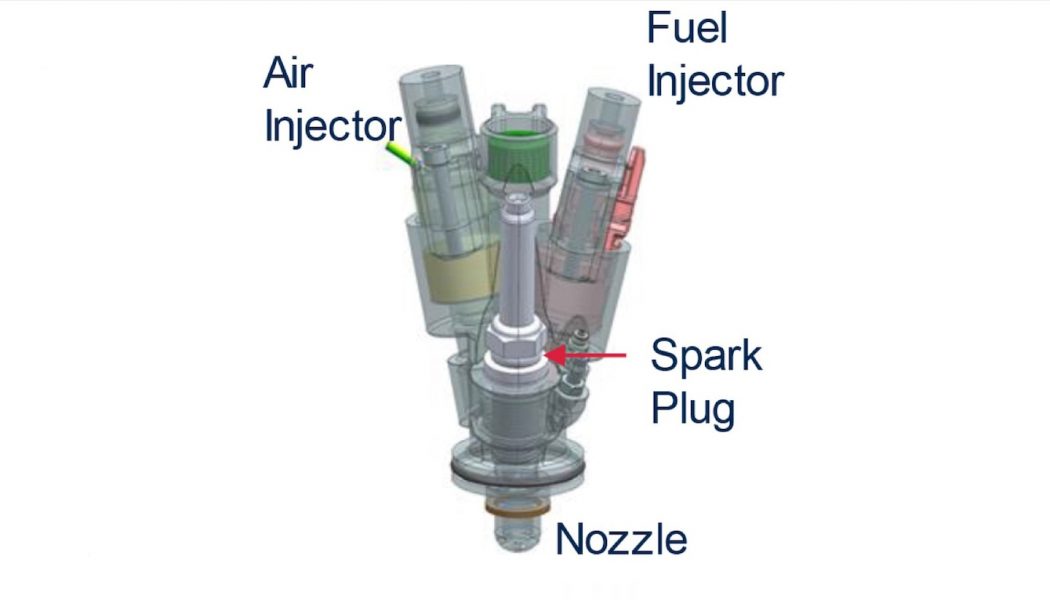Diesel engines used to initiate combustion in a prechamber that housed the glow-plug for cold-starts, but fancy high-pressure direct-injection pretty much retired the prechamber. We’ve recently learned the 2022 Maserati MC20 Nettuno V-6 engine is reviving it—in gasoline engines—as a way to speed the burn rate and extract more work and performance out of the air-fuel mixture. Now we hear Ford is working with FEV, an engineering consultancy, and Oak Ridge National Laboratory on a prechamber engine aimed at boosting efficiency.
The $10-million three-year project, partly funded by the Department of Energy, aims to develop a “Next Generation High Efficiency Boosted Engine.” Specifically, the effort aims to achieve a 23 percent improvement in efficiency and a 15 percent reduction in engine mass relative to the 3.5-liter EcoBoost V-6 in a 2016 Ford F-150 pickup. So while Formula 1 and the Maserati MC20’s Nettuno engine (pictured below) employ the concept to deliver peak performance, Ford, FEV, ORNL, and the Feds are more interested in efficiency. Happily, they’re often two sides of the same coin.
What Does Prechamber Ignition Look Like?
At the top center of the cylinder lies a much smaller chamber that gets its own fuel injector and spark plug. The Ford team is considering somehow cramming a compressed-air injector in there as well. It’s connected to the main chamber by holes large enough to ensure the prechamber gets the same compression as the main cylinder but small enough so that when combustion occurs in the prechamber, it exits these holes as jets of fire that help ignite the mixture in the main chamber.
Ford’s approach can guarantee a rich, easy-to-ignite mixture exists near the prechamber spark plug. Our understanding is that Maserati MC20 prechamber holes are large enough so that fuel injected into the main chamber or drawn in via the port injector can enter. Ford’s concept and the Maserati both employ port injection in addition to a main-chamber direct injector, meaning the Ford prechamber system gets three injectors (likely operating at two different pressures).
How Does Prechamber Ignition Boost Efficiency?
The five individual areas of focus in the DOE-funded project are: engine-knock mitigation, dilute (lean) combustion, thermal management, friction reduction, and weight reduction. The prechamber concept helps with those first two by fostering much faster combustion. The faster the mixture burns, the less need to fire the spark plug early (while the piston is still on its way up) to get the entire mixture to burn. Firing the spark later while still burning all the fuel lowers the temperature. This reduces the likelihood of hot spots forming to cause knock (a cooler burn also reduces NOx pollution). Finally, later, faster combustion means more useful force from combustion gets exerted on the crankshaft while it’s going down. Lean mixtures inherently save fuel but are generally harder to ignite. The prechamber’s fire jets help ignite the lean mixture in the main chamber.
Does It Work and How Much Fuel Can It Save?
Research released to date suggests the burn rate is faster than that of a parallel concept that involves speeding combustion by initiating it with three spark plugs in an otherwise conventional combustion chamber. This same research suggests that all of the team’s knock-reduction efforts pay off by enabling an increase in the compression ratio from a baseline of 10:1 to between 13:1 and 15:1, which boosts fuel efficiency between 6-8 percent. The sum total of dilute combustion efforts enable the engine to run between 30 and 50 percent cooled EGR, which adds another 2-5 percent fuel efficiency.
What Makes Up the Rest of the 23 Percent Fuel Efficiency Boost?
The other knock-reducing technologies include: Enhanced cooling of the combustion chamber via a split cooling system that prioritizes cylinder head cooling, greater piston cooling, and high-thermal-conductivity valve seats and guides. Also contributing to the dilute combustion improvement is an advanced, probably electrified turbo boost system. Another big contributor is continuously variable valve timing that permits Miller Cycle operation, which involves very late closing of the intake valves to reduce the compression load on the crankshaft while leaning on boost to ensure sufficient charge air/EGR (Miller is basically Atkinson plus boost). That one’s credited with 2.5-3.5 percent.
A long-stroke, narrow bore (a 3:4 bore/stroke ratio) design provides a favorable surface-to-volume ratio, shortens flame travel distance, and provides high piston speeds that enhance charge motion, which improves air-fuel mixing and burn rate. The rest is nibbled away in small upgrades, some of which are already in place (like 2-4 percent from upgrading from six to ten speeds in the transmission and 3-4 percent for auto stop/start). The lion’s share of the weight reduction (13.6 percent) is realized by the simplified valvetrain and exhaust, plus integral head/exhaust manifold made possible by switching to an inline-six. A forged carbon-fiber oil pan lops another 2.7 percent, and 3D-printing an optimized cylinder head accounts for another 1.2 percent.
We are tantalized by the notion of a Ford F-150 powered by an F1-inspired combustion system in a BMW-like twin-turbo inline-six-cylinder engine.










